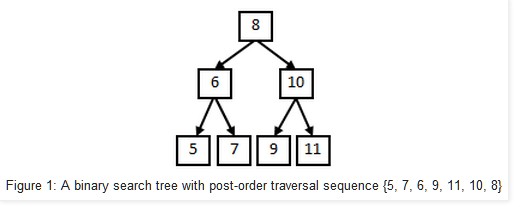No. 06 - Post-order Traversal Sequences of Binary Search Trees
来源:互联网 发布:五五开淘宝店地址 编辑:程序博客网 时间:2024/05/01 05:45
No. 06 - Post-order Traversal Sequences of Binary Search Trees
Problem: Determine whether an input array is a post-order traversal sequence of a binary tree or not. If it is, return true; otherwise return false. Assume all numbers in an input array are unique.
For example, if the input array is {5, 7, 6, 9, 11, 10, 8}, true should be returned, since it is a post-order traversal sequence of the binary search tree in Figure 1. If the input array is {7, 4, 6, 5}, false should be returned since there are no binary search trees whose post-order traversal sequence is such an array.

Analysis: The last number is a post-order traversal sequence is the value of root node. Other numbers in a sequence can be partitioned into two parts: The left numbers, which are less than the value of root node, are value of nodes in left sub-tree; the following numbers, which are greater than the value of root node, are value of nodes in right sub-tree.
Take the input {5, 7, 6, 9, 11, 10, 8} as an example, the last number 8 in this sequence is value of root node. The first 3 numbers (5, 7 and 6), which are less than 8, are value of nodes in left sub-tree. The following 3 numbers (9, 11 and 10), which are greater than 8, are value of nodes in right sub-tree.
We can continue to construct the left sub-tree and right sub-tree according to the two sub-arrays with the same strategy. In the subsequence {5, 7, 6}, the last number 6 is the root value of the left sub-tree. The number 5 is the value of left child since it is less than root value 6, and 7 is the value of right child since it is greater than 6. Meanwhile, the last number 10 in subsequence {9, 11, 10} is the root value of right sub-tree. The number 9 is value of left child, and 11 is value of right child accordingly.
Let us analyze another array {7, 4, 6, 5}. The last number 5 is the value of root node. Since the first number 7 is greater than 5, there are no nodes in the left sub-tree and numbers 7, 4, 6 are all value of nodes in right sub-tree. However, we notice that a number 4, a value in right sub-tree, is less than the root value 5. It violates the definition of binary search trees. Therefore, there are no binary search trees with post-order traversal sequence {7, 4, 6, 5}.
It is not difficult to write code after we get the strategy above. Some sample code is shown below:
bool VerifySquenceOfBST(int sequence[], int length)
{
if(sequence == NULL || length <= 0)
return false;
int root = sequence[length - 1];
// nodes in left sub-tree are less than root node
int i = 0;
for(; i < length - 1; ++ i)
{
if(sequence[i] > root)
break;
}
// nodes in right sub-tree are greater than root node
int j = i;
for(; j < length - 1; ++ j)
{
if(sequence[j] < root)
return false;
}
// Is left sub-tree a binary search tree?
bool left = true;
if(i > 0)
left = VerifySquenceOfBST(sequence, i);
// Is right sub-tree a binary search tree?
bool right = true;
if(i < length - 1)
right = VerifySquenceOfBST(sequence + i, length - i - 1);
return (left && right);
}The author Harry He owns all the rights of this post. If you are going to use part of or the whole of this ariticle in your blog or webpages, please add a reference to http://codercareer.blogspot.com/. If you are going to use it in your books, please contact the author via zhedahht@gmail.com . Thanks.
- No. 06 - Post-order Traversal Sequences of Binary Search Trees
- Leetcode NO.96 Unique Binary Search Trees
- LeetCode No.96 Unique Binary Search Trees
- Pre-order,in-order, post-order of Tree Traversal
- No. 12 - Mirror of Binary Trees
- Breadth-first Search -- Leetcode problem102. Binary Tree Level Order Traversal
- LeetCode刷题笔录Binary Tree Post Order Traversal
- Leetcode NO.107 Binary Tree Level Order Traversal II
- Leetcode NO.103 Binary Tree Zigzag Level Order Traversal
- Leetcode NO.102 Binary Tree Level Order Traversal
- LeetCode--No.102--Binary Tree Level Order Traversal
- LeetCode--No.107--Binary Tree Level Order Traversal II
- leetCode No.107 Binary Tree Level Order Traversal II
- LeetCode No.103 Binary Tree Zigzag Level Order Traversal
- LeetCode No.107 Binary Tree Level Order Traversal II
- leetCode No.103 Binary Tree Zigzag Level Order Traversal
- Reconstruct a binary tree through its pre- and mid-order traversal sequences
- [LeetCode] Construct/build binary tree from in-order and post-order/pre-order traversal
- 扩展开放,修改关闭
- HDOJ 1588 - Gauss Fibonacci
- No. 04 - Paths with Specified Sum in Binary Tree
- No. 05 - The Least k Numbers
- 初学者对通讯录软件开发的整体把握与分块实现------添加列表新内容并实现界面的跳转
- No. 06 - Post-order Traversal Sequences of Binary Search Trees
- No. 07 - Reverse words in a sentence
- No. 08 - Calculate 1+2+…+n
- Semantics in CG language
- 2012-7-12 周五 总结
- No. 09 - Numbers with a Given Sum
- No. 10 - K-th Node from End
- No. 11 - Print Binary Trees from Top to Bottom
- [开源] 本blog的开源项目


